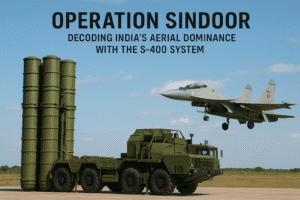Operation Sindoor: Decoding India’s Aerial Dominance with the S-400 System
India’s retaliatory Operation Sindoor (May 2025) saw its S-400 air defense system achieve unprecedented success, downing five Pakistani fighter jets and a critical AEW&C aircraft at 300 km range – the longest confirmed surface-to-air kill in combat history. Air Chief Marshal AP Singh confirmed these strikes crippled Pakistan’s air capabilities, including damage to F-16 hangars and command centers at Jacobabad, Murid, and Chaklala. The high-tech, 90-hour operation forced Pakistan to de-escalate, recognizing further losses were inevitable. This demonstration of the S-400’s lethal effectiveness reshapes regional air power dynamics, validating India’s strategic deterrence while underscoring the evolving nature of modern aerial warfare where technology dictates battlefield outcomes.

Operation Sindoor: Decoding India’s Aerial Dominance with the S-400 System
Strategic Insights Beyond the Headlines
The Catalyst: A Retaliatory Strike
Operation Sindoor, launched on May 7, 2025, was India’s calibrated response to the Pahalgam terror attack (April 22). Air Chief Marshal AP Singh’s recent confirmation of 5 Pakistani fighter jets and 1 advanced AEW&C aircraft shot down—all by the S-400 Triumf system—reveals a tactical shift in South Asian air warfare.
Why the S-400 Changed the Game
- Unprecedented Range: The downing of an aircraft at 300 km—near the S-400’s maximum range—demonstrates India’s ability to dominate airspace deep inside hostile territory.
- Electronic Warfare Edge: The destruction of Pakistan’s AEW&C (critical for radar coordination) crippled their situational awareness, effectively blinding their air defense.
- Psychological Impact: Strikes on Jacobabad’s F-16 hangar and command centers (Murid/Chaklala) exposed vulnerabilities in Pakistan’s most secure facilities, forcing a strategic retreat.
The Unspoken Calculus
- High-Tech Asymmetry: India’s “80–90 hour war” leveraged networked sensors, drones, and precision strikes—avoiding mass troop deployments.
- Pakistan’s Concession: ACM Singh implied Pakistan halted hostilities not just due to losses, but the realization that escalation would amplify damage.
- The U.S. Angle: Trump’s ceasefire claims, repeatedly denied by India, hint at behind-the-scenes diplomatic pressures amid U.S.-Pakistan defense ties.
Broader Implications
- Deterrence Validated: The S-400’s combat debut signals to China and other rivals that India can neutralize advanced aircraft.
- Redefining Conflict: Short, intense engagements with standoff weapons may replace prolonged battles in future India-Pakistan clashes.
- Regional Stability: While showcasing strength, India avoided crossing Pakistan’s nuclear threshold—a delicate balance policymakers navigated.
The Human Element
Behind the “5 confirmed kills” statistic lies untold stories: Pakistani pilots’ fates, the terror attack victims that triggered this operation, and the IAF personnel who executed high-risk missions. War’s cost transcends wreckage tallies.
Why This Matters Beyond Nationalism
This conflict underscores a global trend: air defense systems now dictate battlefield outcomes. For India, the S-400 investment proved its worth; for smaller nations, it’s a stark lesson in technological disparity. Yet lasting peace requires channeling such capabilities into deterrence—not escalation—amid South Asia’s complex tensions.
You must be logged in to post a comment.